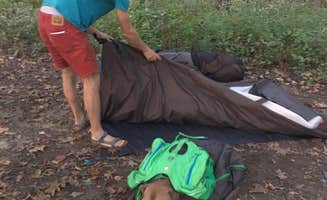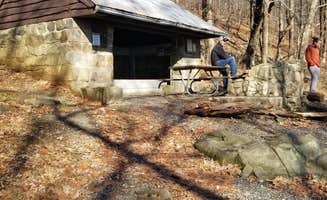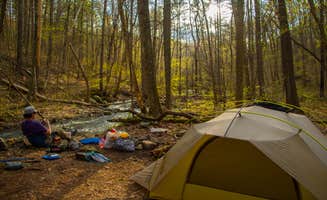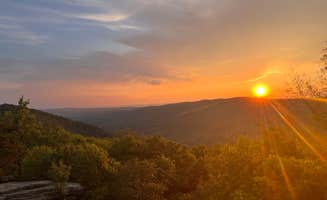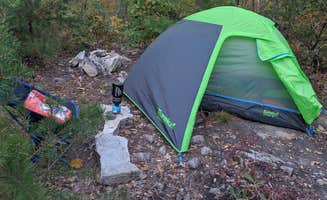Rustic camping near Centreville, Virginia primarily requires backcountry hiking and preparation for remote conditions. Most primitive sites in the region require permits and sit on national forest or park land, with elevations ranging from 800 to 3,500 feet across the area. Seasonal weather patterns significantly impact water availability and trail conditions, with spring offering flowing creeks while summer months often require carrying additional water supplies.
What to do
Hike the Appalachian Trail sections: The AT runs through several backcountry camping areas, including Gravel Springs Hut. "The hut is 3 sides and open on the 4th, the open side faces the fire pit. There is a picnic table, privy, bear locker, and bear pole to hang additional items at the site," notes camper Mara F. about this first-come, first-served shelter.
Search for wildlife viewing: The forests around Shenandoah National Park Dispersed Sites host diverse wildlife. "I got to sleep listening to a river all night. It is also convenient since most places are not far from the trails," explains Stephanie R. about the backcountry camping experience.
Plan multi-day treks: Connect multiple primitive campsites for extended backpacking trips. The varied terrain allows for customized routes from beginner to advanced. "We spread out over 4 RV/camper/tent sites as our base camp... We even took a group out hiking across the AT and did some backcountry camping," shares Amanda D. about using established campgrounds as starting points.
What campers like
Ridgeline vistas: Veach Gap - GWNF - Backpacking Site offers panoramic mountain views after a challenging hike. "Amazing Campsite. Breathtaking views of the Shenandoah River and surrounding mountains. Very much worth the 4 mile hike up to the site. 1,200ft elevation difference from the trailhead to the site," writes TJ W.
Seasonal variety: The changing seasons transform the camping experience. "As we hiked down through the life zones to our first camp along Overall Run, a nearly 2000+ foot elevation change, the seasons changed from winter to spring!" notes Shari G. about early spring backpacking.
Solitude opportunities: Primitive sites offer escape from crowds, especially on weekdays. "It is suitable for novice campers to experienced off-trail campers. You'll never tire of the wonders this beautiful piece of America has to offer," explains Teresa K. about Shenandoah National Park Dispersed Sites.
What you should know
Water access challenges: Many primitive sites have limited water sources. At Veach Gap - GWNF - Backpacking Site, "there is no water after the first mile. I have seen a small trickle part way up the mountain, but don't count on it. Pack up all the water you will need for the day/evening/morning," cautions Jon N.
Permit requirements: Backcountry camping in Shenandoah requires permits, available at entrance stations. "These sites are backcountry meaning they are not established sites. You just wander down the trail and pick your favorite spot with consideration to not disturbing as much nature as possible," explains Stephanie R.
Seasonal insect activity: Bugs can be problematic, especially in warmer months. At Compton Gap, one camper noted, "Lots of bugs. Hiked in from the Dickey ridge trail parking lot," describing their experience as "Buggy and damp."
Tips for camping with families
Choose shorter approach hikes: For families with children, select sites with shorter access trails. "I recently led a large group of Scouts to the Mathews Arm Campground in SNP... We had a lovely hike to a nearby waterfall that was gorgeous," reports Amanda D.
Bring sufficient food storage: Wildlife protection requires proper food storage. "There is a picnic table, privy, bear locker, and bear pole to hang additional items at the site. The hut sleeps 8 and is first come, first serve," mentions Mara F. about Gravel Springs Hut.
Check cell service availability: Signal is unpredictable in mountainous terrain. "Cell service at the top (not during the hike or on the road to the trailhead so prepare directions)," warns TJ W. about Veach Gap, emphasizing the need for offline navigation.
Tips from RVers
Use established campgrounds as base camps: Since most primitive sites aren't accessible by vehicle, RVers should establish at developed campgrounds first. "I absolutly love this national park! The facility is clean, trails are well marked and there are plenty of different day hikes and camping grounds," shares Anthony S. about Compton Gap Backcountry camping.
Be aware of entrance fees: Park access may require payment regardless of camping location. "This place was $30 just to enter and it was super duper packed. We turned around and found a great boondocking site nearby," notes Alexandra T., highlighting the need to research alternatives during peak periods.
Plan for primitive conditions: Facilities are minimal at dispersed sites. "There are about 5 campsites, one was reclaimed by Mother Nature. But you can still find a bench right in front of a fire pit," explains Ashley F., describing the natural reclamation that occurs at less-maintained areas.


